Gouache or Acrylic: What Are the Differences?
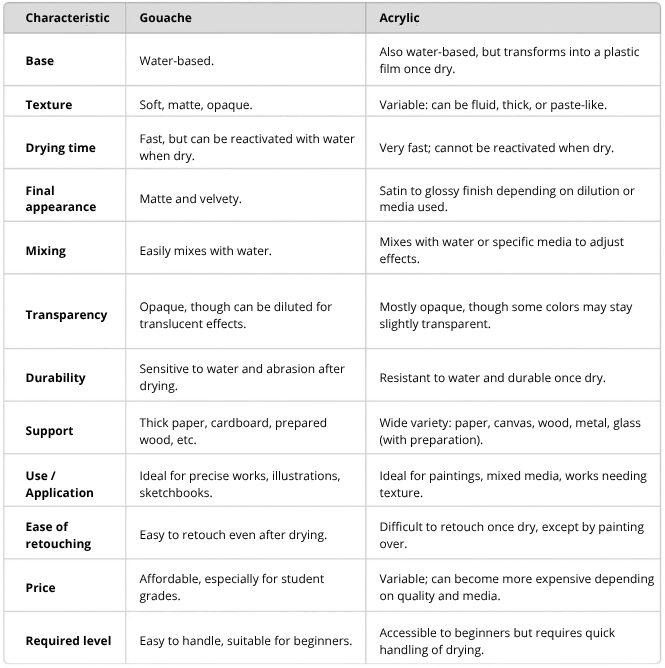
Are you interested in starting painting but are hesitating between gouache and acrylic? Or have you already started with one and are wondering if the other might suit you better? Don't panic, you are in the right place! In this article, we will explore in detail the characteristics of these two types of paint to help you better understand their properties and uses so you can decide which is best for you.
UNDERSTANDING THE BASICS
Let's start with the basics. You have probably already used gouache or acrylic paint, perhaps in elementary school for the former and in middle school for the latter. If you have memories or prejudices about one or the other (or both), set them aside. The paints we are made to try as children are often of poor quality, providing a quite disappointing first experience. If you want to seriously get into one of these techniques, you will need to invest in better quality paints.
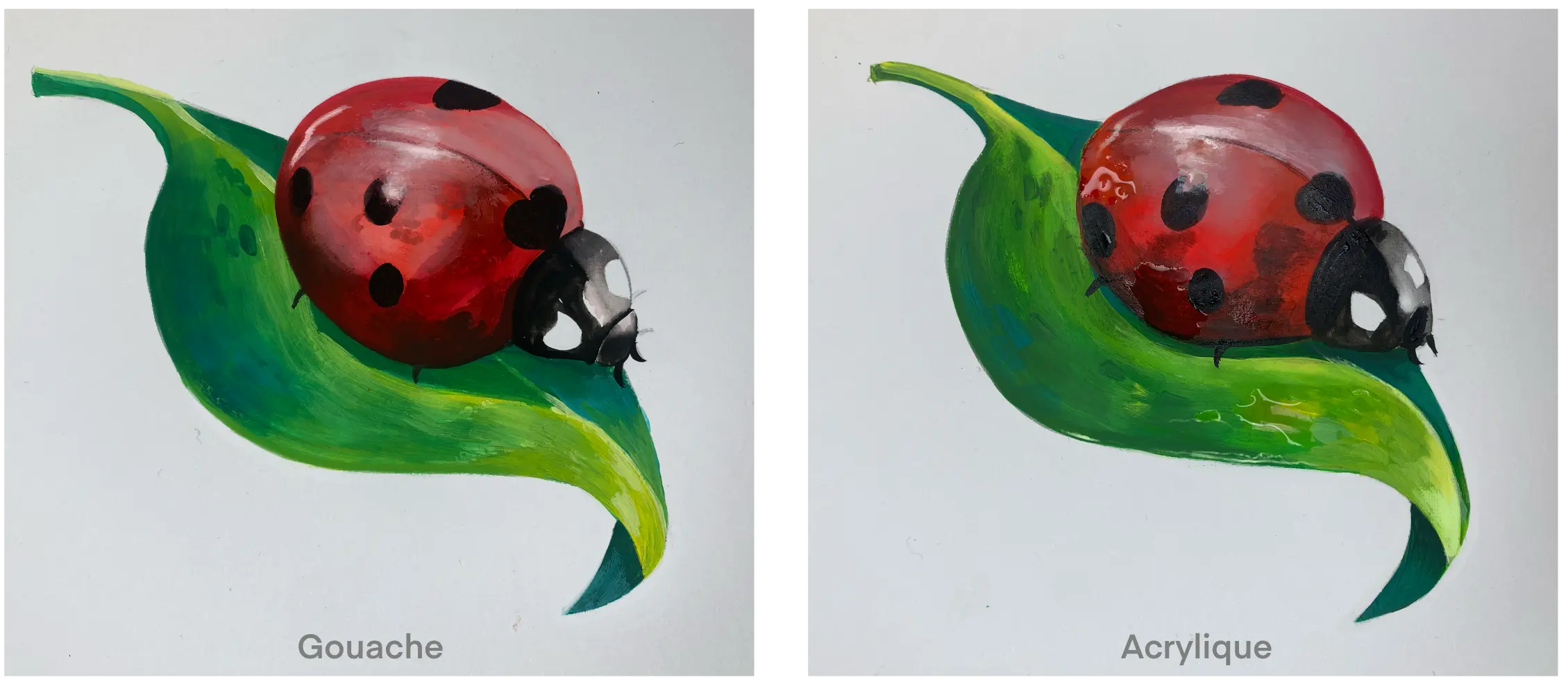
LET'S COMPARE THE FEATURES OF GOUACHE AND ACRYLIC
COMPOSITION
The main difference between gouache and acrylic lies in their composition. Gouache is a water-based paint, made of pigments mixed with gum arabic, which gives it a matte appearance and the ability to be reactivated with water once dry. Acrylic, on the other hand, uses pigments bound by an acrylic resin, a plastic material that becomes waterproof when dry.
OPACITY
Gouache and acrylic are both opaque paints. However, gouache generally requires one to two coats to achieve a perfect, uniform flatness, while acrylic might sometimes require more.
The opacity of these paints can also vary depending on their quality and pigment concentration. That's why it's possible to come across gouaches or acrylics that have a slightly transparent appearance. Generally, the better the opacity a paint provides, the more you can be sure of its quality.
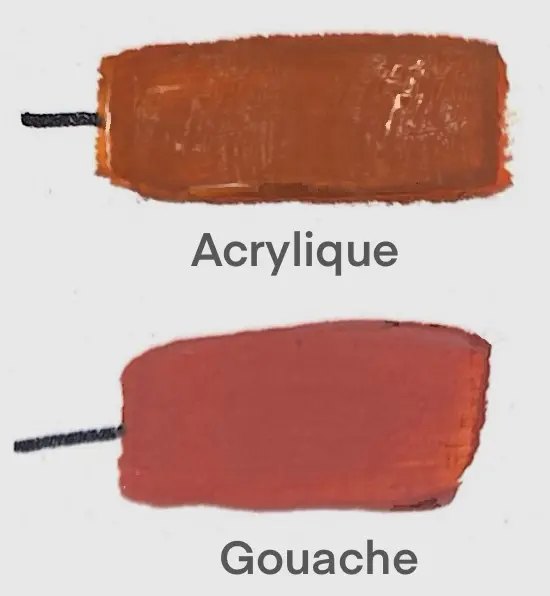
DILUTION
Gouache and acrylic can be diluted with water to achieve a range of varied shades. However, the more you dilute your paint, the more transparent it will become. Gouache has the advantage of being able to be reactivated with water indefinitely, whereas acrylic, once dry, cannot be. To work with more flexibility, it is possible to use acrylic mediums, which allow for delayed drying, facilitate washes and enable the fluidity of the paint to be adjusted.
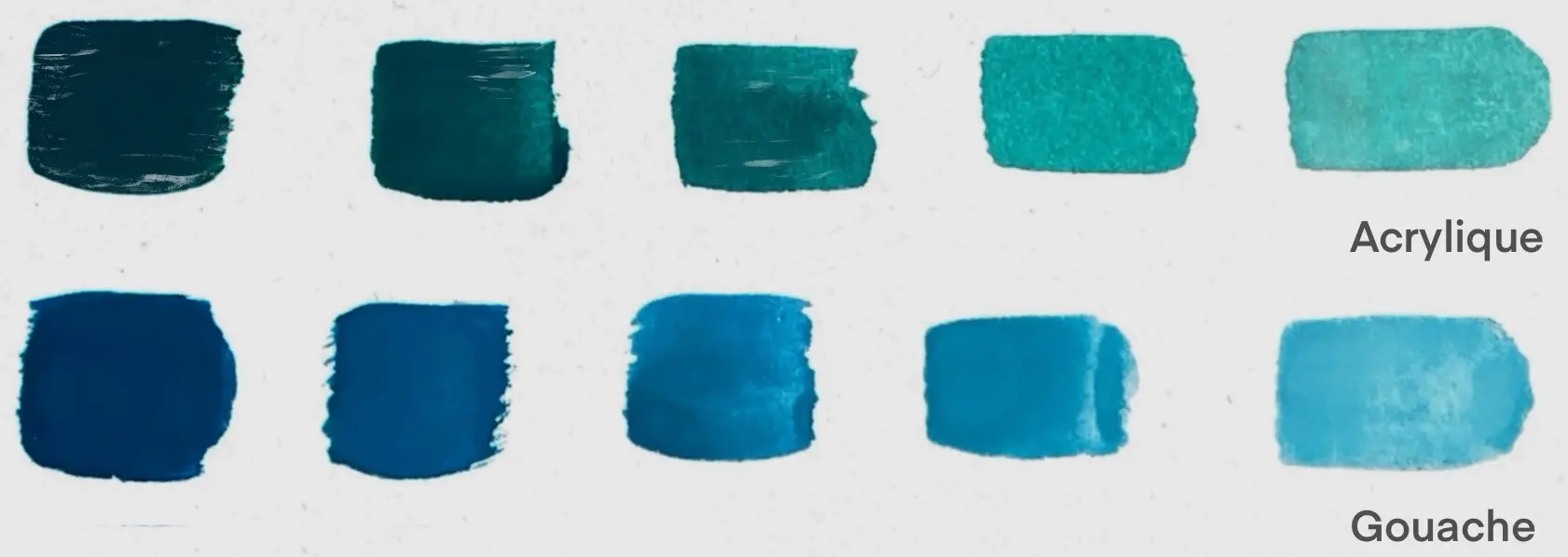
COLOR RENDERING
In terms of color rendering, when comparing relatively similar ranges between acrylic and gouache, they are generally very good. Both paints offer intense and rich pigments, thus providing beautiful colors.
However, gouache still tends to lose a bit of its brightness as it dries, which can result in a softer and less saturated outcome. Dark colors lighten slightly and light colors darken a bit.
Acrylic, on the other hand, better preserves the vividness of colors, especially if applied in thick layers or with mediums. The shades appear deeper and more vibrant.
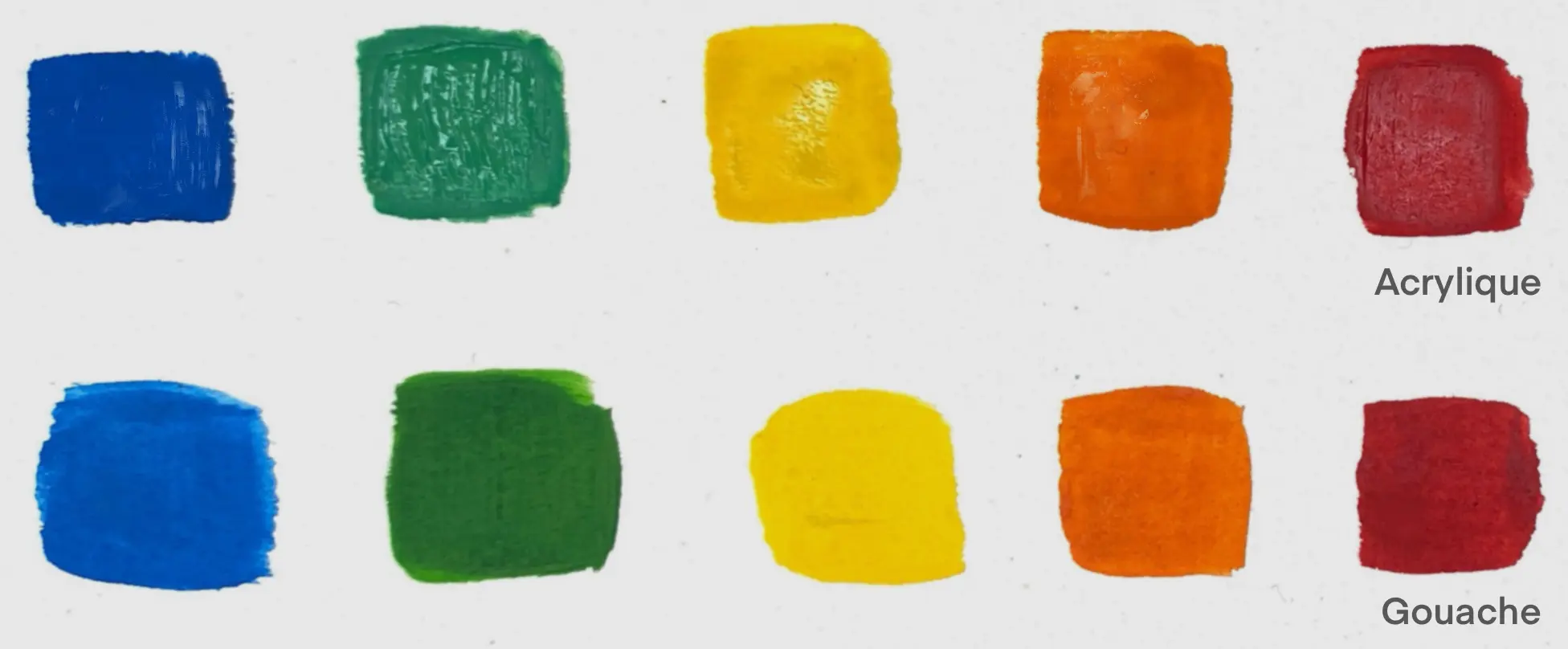
DRYING
Gouache dries quickly, but remains workable by adding water. Its finish is always matte and uniform. Gouache is ideal if you want to create reproductions of your paintings by digitizing them, thanks to its complete lack of reflections. Acrylic dries very quickly and becomes waterproof, which can be problematic for smooth transitions. The finish varies between matte, satin or glossy, depending on the addition of mediums.
Obviously, the more diluted your paints are, the quicker they will dry. Conversely, the thicker the layer of material you work with, the longer the drying time will be.
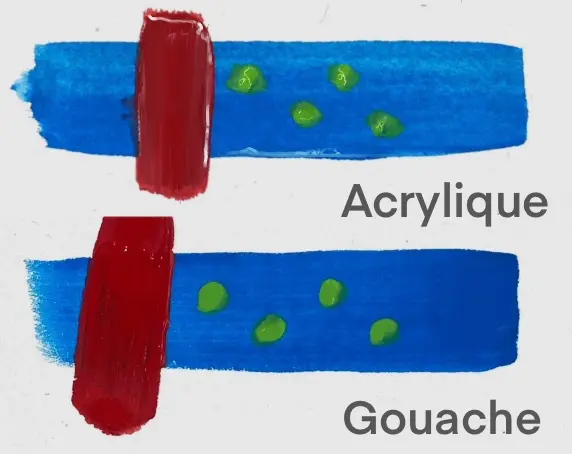
GRADIENTS
To create gradients, both types of paint require a bit of technique. However, it is easier to do with gouache, because its ability to be reactivated with water allows for better blending of colors. With acrylic, you need to be quite fast to ensure the colors blend well, otherwise one of them might dry too quickly and create harsh lines.
Generally, these paints are not the easiest for creating gradients (compared to watercolor or oil paint, for example). This will force you to develop your technique or to find new ways of proceeding.
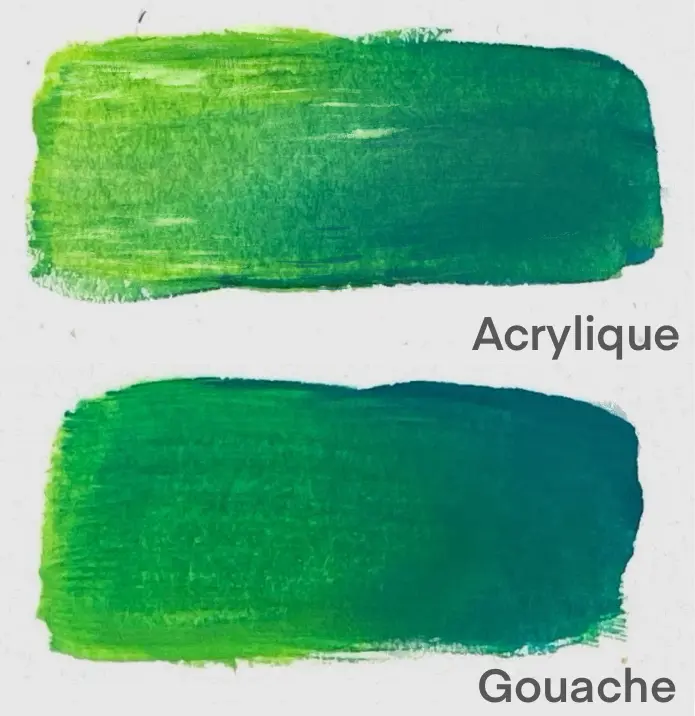
MATERIALS
As for materials, gouache is ideal on absorbent materials such as paper (minimum 200 g/m²), cardboard or wood. It does not adhere well to smooth surfaces, such as plastic or glass, and can easily peel off if applied to non-porous materials.
Acrylic is more versatile: it can be used on paper, canvas, wood, glass, metal, or even fabric, as long as the surface is prepared beforehand. For instance, when painting on fabric, it is recommended to use a special medium to ensure good adhesion and prevent the paint from cracking during washing.
GOUACHE AND ACRYLIC: HOW MUCH DO THEY COST?
Regarding the cost, as this can be an essential factor in the decision, the price remains relatively similar with equal quality. If we take the examples below, by choosing the same brushes and the same paper suited for both types of paint and calculating the price ratio of the paints relative to their container, the cost is almost identical (about €37.40 for acrylic versus €36.85 for gouache, with 4 more colors).
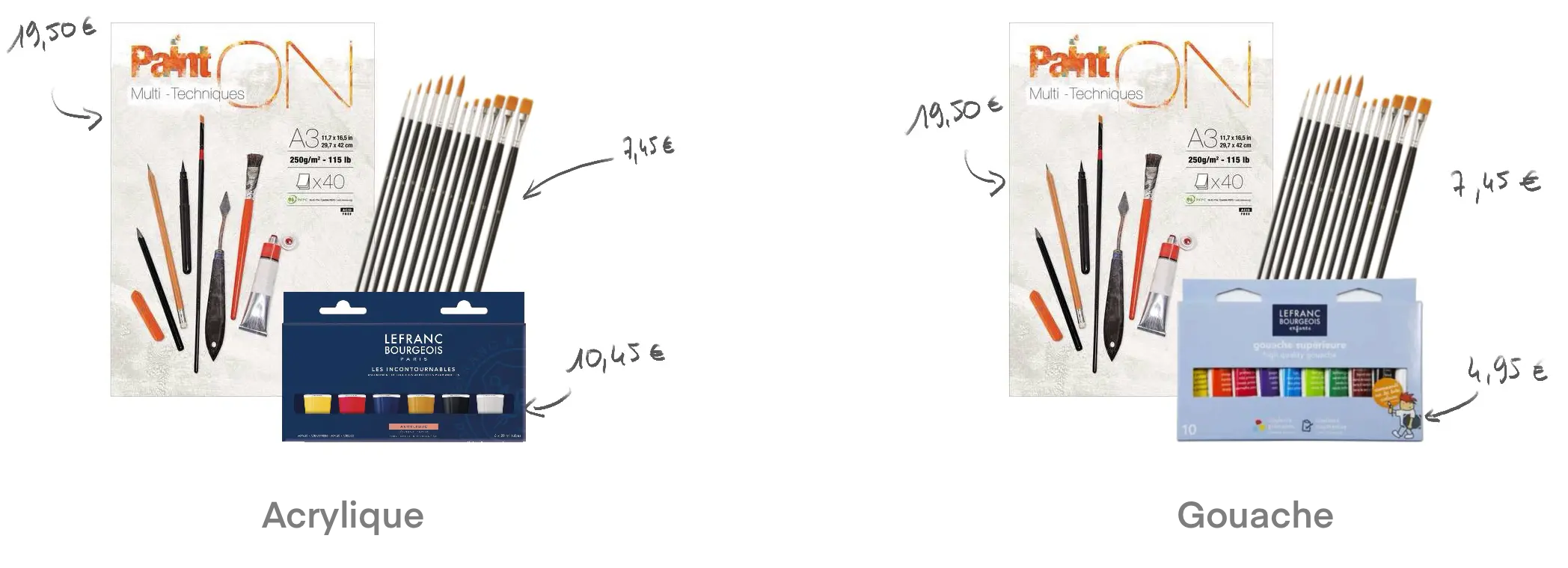
Generally, gouache is often considered more affordable. This is partly because acrylics may require additional mediums to modify the texture or slow down the drying time, which can increase the overall cost. In the long run, gouache can therefore turn out to be less expensive for beginners, as it does not require additional purchases.
That said, it is important to note that some high-end products in both categories may be more expensive, but offer better coverage and durability, a crucial aspect for those who plan to create lasting or large-scale works.
If you want to start without investing too much, here is a small kit that might suit you well:
Paper: https://frp.geant-beaux-arts.fr/?P422AB583E2D131
Brushes: https://frp.geant-beaux-arts.fr/?P422AB583E2D131
Acrylic: https://frp.geant-beaux-arts.fr/?P422AB583E2D131
Gouache: https://frp.geant-fine-arts.uk/?P422AB583E2D131
THE ADVANTAGES AND DISADVANTAGES OF GOUACHE AND ACRYLIC
If we were to make a summary of gouache:
- Ease of use and editing.
- Matte finish.
- Less durable over time, especially without protection.
- Limitation to absorbent materials.
Gouache is therefore ideal for beginners and those looking for a matte finish. It is particularly used for illustration-like rendering (especially in children's book illustration). It is also a good choice for projects requiring frequent touch-ups, or if you are short on time for painting and wish to frequently rework your painting.
If we were to make a summary of acrylic:
- High durability and resistance.
- Adaptability on almost all media.
- Possibility to create varied effects with mediums.
- Quick drying time, which complicates touch-ups.
- Requires more equipment (mediums, wet palettes).
Acrylic is therefore more suitable for those looking to work on a variety of surfaces and to create durable works. It is perfect for more abstract or textured styles and suits experienced artists who are ready to invest in additional mediums and accessories.

In summary, gouache is ideal for those looking for an easy-to-use and retouchable paint, whereas acrylic is better suited for those who prioritize durability, versatility and the ability to work on various surfaces.
And there you have it, now you have all the information needed to choose the paint that suits you best between gouache and acrylic. I hope you enjoyed this article, and most importantly, have fun! 😊
Writer: Chloé Pouteau

